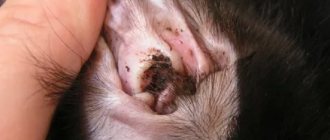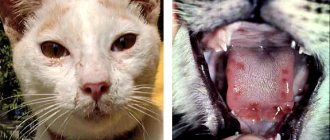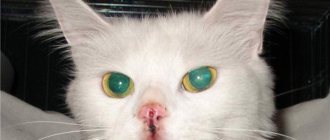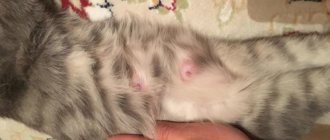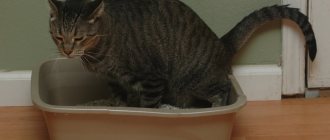Often, pet owners, when they see black plaque in a cat’s ears, do not attach any special significance to this phenomenon. They think that it’s just dirt and dust accumulated in the ear, so they try to remove the plaque with cotton swabs, or do nothing at all to get rid of the problem. The opinion that black plaque does not cause any discomfort or harm to the animal is erroneous. It is worth understanding what the reasons are for its appearance and how to eliminate such plaque.
The cat has black plaque in his ears. Where to go?
- Ace Ventura. Laboratory diagnostics for ectoparasites (otodectosis, etc.) 400 rubles. You can call a doctor at home. The cost depends on the distance from the clinic and varies from 1,000 to 10,000 rubles. Address: Academician Vinogradova street, 1k1, 1st floor.
- Aura Clinic. Analysis for otodectosis 200 rubles. Initial appointment 650 rubles. Address: Verkhnie Polya street, 36k1.
- Vega Clinic. Microscopy of ear contents for otodectosis 340 rubles. Appointment with a dermatologist is 1,500 rubles, a therapist is 765 rubles. Address: Marshal Katukova Street, 17k1, 2nd floor.
- Felis Veterinary Clinic. Taking scrapings for the presence of pathogenic fungi and mites (demodex, otodectosis) without the cost of examination (with materials) 200 rubles. Initial appointment is 400 rubles. Address: Udarnikov Avenue, 38 building 1, 1st floor.
- Center for Veterinary Diagnostics and Minimally Invasive Surgery TrustVet. Microscopy of skin scrapings, earwax to detect subcutaneous mites of the genera Sarcoptes, Notoedres, Demodex, Otodectes 600 rub. Appointment with a therapist costs 800 rubles. Address: Komendantsky Prospekt, 27 k1, ground floor.
Special cases
There are also special cases that we have already indirectly mentioned above.
We are talking about some cat breeds that, as a result of many centuries of selection, have acquired some specific characteristics. In particular, sphinxes have ears that are so “original” that they have no ability for natural self-cleaning at all. In addition, this breed has another feature: their ears produce particularly large amounts of wax. Normally, it protects the ears from pathogenic and conditionally pathogenic microflora, as well as foreign objects, but sphinxes have too much of it. And therefore, heavy plaque inside the hearing organs is commonplace for such cats.
If plaque is only in one ear
In cases where there is plaque in only one ear, we can talk about:
- Or is it an individual feature of a cat that synthesizes more sulfur in one ear (this happens, and is not so rare).
- Or, what is much more likely, one ear is already affected by a tick, or an inflammatory process of a different etiology has already developed there. You shouldn’t expect miracles: over time (more precisely, very soon), parasites or harmful bacteria will end up in the second ear. Moreover, if we are talking about otodectosis, both ears will still have to be treated.
What does a strong smell from the ears mean?
Nothing good. Normally, cats' ears, although they do not smell lavender, still do not cause gag reflexes.
Therefore, a pungent odor may appear in the following cases:
- Fungal infections (we have already written that the smell is very specific).
- Purulent inflammation.
- Advanced forms of otodectosis.
Diagnostics
To establish an accurate diagnosis and choose treatment tactics, the otolaryngologist conducts a comprehensive examination of the patient. When evaluating the allocated secret, the following characteristics are taken into account:
- color;
- smell;
- volume;
- presence of additional symptoms.
Instrumental methods for examining pathologies:
- CT scan. It is carried out to exclude injuries to the skull bones.
- Otoscopy. With its help, you can see the development of the inflammatory process.
- Microscopy. Needed for a more detailed inspection of damaged areas.
Reasons for rejection
Inspecting the ear canal yourself is not difficult if you arm yourself with a small flashlight. During the procedure, bend your ear slightly, turning it inside out. There is no need to be afraid that your pet will be in pain, since if you act carefully, the discomfort will be minimal.
The inside of the ear canal must be clean, free of contamination in the form of dust or dirt. Brown bumps or black spots may indicate the presence of the disease. The table below describes the most common causes of contamination.
| Cause | Sign |
| Otodectosis (presence of mites) | The animal develops a brown coating similar to dirt in its ears. A cat with a tick is bothered by itching and inflammation |
| Sulfur plug | If a large amount of dust and dirt gets into the sink, then sulfur begins to be produced more actively. If sulfur is not removed from the passage in a timely manner, the animal begins to hear worse |
| Ear diseases | Ailments such as otitis media, fungus, allergies and infections can provoke the appearance of pollution. In the process of inflammation, purulent discharge is formed, resulting in dirt and an unpleasant odor. |
| Particles of debris and dust | If you don’t clean the sink regularly, various contaminants from the environment begin to accumulate in it. |
Quite often, a cat who lives at home and does not go outside has dirty ears. Basically, this phenomenon occurs in breeds that have no or very little hair on their ears. This natural protection prevents dust from getting inside. In this case, you should clean the ear canal more often and inspect it especially carefully for the presence of debris and foreign objects.
Why does plaque appear?
Lack of hygiene
Earwax in cats, like in humans, has a protective function against the entry of pathogenic fungi, bacteria and small insects into the ear canal. It also serves as a lubricant for the inner canals of the ear. The auricle itself secretes a small amount of sebum. If a lot of wax and fat accumulate in the ears, dirt and dust stick to them. Because of this, a black coating is formed, especially noticeable in breeds with large ears and open ears - American Curl, Sphynx, Rex, Havanese, Javanese, Siamese, Oriental Shorthair cats.
Ear mite
The causative agent of otodectosis is the microscopic oribatid mite Otodectes. It parasitizes not only cats, but also dogs, rodents, and ferrets. Therefore, infection of a domestic cat is possible from other pets visiting the street. A sick cat can also infect all the pets living in the room with it. Most often it develops in animals with weak immunity and lack of hygiene. The parasite is very rare in humans and causes otitis externa.
Brown dirt in a cat's ears: how to get rid of it?
Cats have excellent hearing and pleasantly surprise owners with their abilities. In order for your pet to always remain healthy and not experience problems with the ears, it is necessary to periodically examine them.
When your four-legged pet has brown plaque in its ears, you should first of all rule out the possibility of an ear disease.
If brown discharge in a cat's ears is accompanied by other painful symptoms, it means the pet is sick.
What could a cat be sick with?
In some cases, the cause of plaque in the ears is ear mites. Parasites live in the ear and external meatus, causing inflammation. A cat can pick up ticks through contact with other pets or while outdoors. When otodectosis occurs, dark discharge forms in a cat's ears; in severe cases, plaque accumulates on the outer part of the ear.
It is easy to know that a cat is infected with ear mites by the following symptoms:
Otitis externa is another reason why brown dirt appears in a cat's ears. In this case, redness or swelling of the ear canal occurs.
The cat becomes irritable or, on the contrary, becomes depressed. When the ears are touched, the animal experiences pain. In the case of external otitis, the pet sometimes shakes its head or tilts the sore ear towards the floor.
A brown plaque with an unpleasant odor appears in the middle of the ear.
When an infection gets into the ear canal or the eardrum is damaged by a foreign object, otitis media sometimes occurs. The disease is much more dangerous than the external form of otitis. You can find out about inflammation of the middle or inner ear by purulent discharge from the ear cavity. Another sign of the disease is the appearance of problems with balance, gait or jumping in the cat.
Possibly Why does the Sphynx have spots on its skin?
Bacteria and yeast can cause ear infections.
In the presence of favorable factors (moisture, disturbances in the functioning of the body), bacteria quickly multiply and cause discomfort in the pet. It is possible to identify the presence of pathology by the cat’s behavior. The animal behaves restlessly.
Ear infections can be caused by hormonal imbalances, allergies, or genetic diseases.
Other causes of plaque
If something brown appears in a cat's ears, this does not always indicate that the pet is sick. Such plaque may be ordinary sulfur plugs. It is necessary to examine the cat's ear cavity once a week, and also clean the ears once every two weeks to combat dirt. It will not be difficult to cope with such a task, armed with ordinary ear sticks.
Ear cleaning is best done by adhering to the following rules:
- First of all, you need to wrap your pet in a towel so that he does not scratch during the procedure. It is best to talk to the cat during the cleaning process, so the pet will calm down faster;
- Use cotton swabs, napkins and olive oil. When cleaning the ear cavity, you must be as careful as possible so as not to damage the integrity of the eardrum;
- If the wax plugs have already dried out, then you need to dip a cotton swab in a small amount of olive oil and then lubricate the inside of the ear. At the final stage, it is recommended to wipe the ears with a napkin.
Chlorhexidine can be used as a disinfectant solution.
Preventive measures
Preventing ear diseases is not difficult. It is enough to regularly inspect the ear cavity for mites, foreign objects and plaque. Do not forget that a small amount of brown discharge may be present in your pet’s ears - this is considered normal.
In the case when, in addition to the brown plaque, the pet is also bothered by other symptoms that cause him discomfort, you should be more careful. If there is an unpleasant odor coming from the auricle and the hearing organ looks unhealthy, this is a reason to take the cat to the veterinarian.
Drops help in fighting ear infections
Before using the medicine, it is important to clarify the correct dosage of the drug and treatment regimen. If you first study the instructions indicated on the package, it will not be difficult to make the treatment effective
After all the manipulations, you should treat your pet with a treat.
To effectively combat ear pathologies, in addition to drops, tablets, powders and injections can also be used. If you carefully monitor the condition of your cat’s ear cavity and maintain hygiene, many problems can be eliminated at the initial stage.
When to sound the alarm?
If black spots and spots in a cat's ears are caused by poor hygiene, the animal remains calm and playful, and has a good appetite. The ear itself is white, not inflamed. Anxiety is caused by brown discharge, which is a waste product of the tick. Dangerous symptoms at different stages are shown in the table:
| Stage | Symptoms |
| Initial | The mite penetrates under the skin, irritating the nerve endings |
| The ear is very itchy and painful | |
| Redness and swelling of the external auditory canal | |
| Brown plaque in the ears that resembles asphalt | |
| Unpleasant smell | |
| Average | Dark crusts form and plugs form |
| Severe itching, the cat shakes its head and screams | |
| The appearance of scratches and wounds | |
| The auricle is lowered, the animal’s head is leaning towards the side of the affected ear | |
| Anxiety, aggression, poor sleep and appetite | |
| The mite spreads to the natural bald patches near the ear and muzzle, causing it to swell | |
| Perforation of the eardrum and introduction of mites into the inner ear | |
| Heavy | Dark plaque is visible not only inside the organ, but also on the tips of the ears |
| Parasites invade the brain, causing inflammation | |
| Sick animals meow loudly in pain | |
| Refusal to eat, apathy, seizures | |
| Possible death |
Return to contents
Prevention of ear diseases and ear hygiene in cats
If your pet has had an ear infection, often walks outside, or is hypothermic, then he may get sick again. It is necessary to use preventive measures to protect it from all factors that cause black plaque inside the ear.
Basic preventive measures:
monitor the condition of the cat’s ears and promptly clean them with a cotton swab or cleansing lotion; pay attention to high-quality animal feed with a vitamin complex, avoid feeding food from the table; give vitamin and mineral supplements to boost immunity; do not let your pet become ill; consult a doctor in a timely manner; isolate the animal from contact with stray and infectious animals; do preventive treatment of your pet against fleas and ticks, for example, with the drug fleanet max.
If a cat has black plaque in his ears, wipe the auricle with a cotton pad. Cotton swabs are not recommended for use, as they are harsher and can injure the cat's ear.
Wiping the ear with an antiseptic
Hydrogen peroxide, black and green tea, and salicylic alcohol are also used to wipe the ear. They treat the affected areas before applying the main product.
If the animal is already starting to scratch its ears, then as a preventive measure for otodectosis, you can administer a course of drops, for example, leopard or otovedin.
If you notice a cat's restless behavior and scratching of its ears, it is necessary to examine the animal's ears for brown plaque. If plaque is detected, you need to contact a specialist to diagnose and develop a treatment plan for your pet. While waiting for a doctor's appointment, the animal's ears are wiped with damp cotton swabs and the preparations Bars and Otovedin are used against ear mites.
Video
https://youtube.com/watch?v=wtNC6%2520%E2%80%B3%26gt%3B
Associated symptoms indicating pathology
In the case when the appearance of dark dirt in the ears of an adult cat or kitten is associated with dust, in order to get rid of it for 1-2 weeks, it is enough to wipe the pet’s ears with a damp cotton pad and clean the auricle with a cotton swab. However, if after cleansing the plaque quickly accumulates again, this is a sign of the development of pathology. The table describes symptoms that occur for various reasons.
| Pathology | Characteristic symptoms | Specific signs |
| Otodectosis |
| Gradually the brown coating turns black. As the disease progresses, a lot of dark dirt appears and purulent wounds form. |
| Otitis |
| As the pathology develops, the unpleasant odor becomes more intense. In the advanced stage, the cat begins to hear poorly. |
| Sulfur plug | After infection enters the ear, signs of otitis media are observed. | |
| Allergy |
| With allergies, unpleasant symptoms disappear or become less noticeable in the absence of contact with the allergen. |
| Fungus |
| The pet's skin becomes dry, the coat loses its shine. |
| Necrosis |
| Gradually, the cat’s condition worsens, and deformation of the auricle appears. |
Characteristic symptoms
The animal cannot say in words what exactly is bothering it, so it expresses its discomfort through various behavioral actions. In the case of ticks, these will be the following symptoms:
- The cat begins to behave very restlessly, constantly jerking its head, as if trying to shake off parasites.
- He tries to get into the ear canal with his paws, gets nervous when he can’t penetrate deeper, and scratches his ears until they bleed.
- In a desire to get rid of constant itching, the cat looks for hard, stable pieces of furniture to rub its head on, or “sticks” to door frames, corners and steps.
- Dark brown and brown liquid oozes from the combed ears. An unpleasant odor appears. The pile in the lower area of the ear tassels sticks together.
- Partial or complete loss of hearing is observed.
- Body temperature rises slightly.
Important: in order not to blur the clinical picture, it is not advisable to carry out any hygiene procedures before visiting the veterinarian. You should also refrain from instilling drops or applying any ointments.
These crusts consist of a large number of small grains
If the auricle is damaged by a mite, it is necessary to systematically clean the ears. Using a cotton swab dipped in ear cleaner, carefully remove all crusts, mites and their deposits.
After this procedure, the surface of the ear should become clean. Next, special ear drops must be instilled into the ear. This is done in order to expel parasites from the deeper part of the ear. After administering the medicine, it is better to massage the ear for a few seconds so that the medicine reaches its target and is evenly distributed over the surface.
It often happens that several cats live in an apartment. In this case, in order to prevent infection with ear mites, all pets need to have their ears cleaned. These hygiene procedures should be observed not only if the animal is walking on the street, but even if the animal does not visit the street. After all, the owner can bring parasites from the street, for example, on shoes.
2. Another cause of itchy ears can be the sarcopid mite. What distinguishes it from an ordinary tick is that it affects not only the auricle, but also the nose and eyes. If treatment is not started on time, the mite can spread throughout the body and thereby cause a disorder of the nervous system. Symptoms include dry skin, cracks and bleeding wounds. To treat this disease, an integrated approach is required, increasing immunity and, possibly, prescribing antibiotics in case of suppuration of wounds.
3. Another reason is suppuration of wounds - abscess. This disease can develop when an infection enters a wound or scratch. This often happens if, for example, a cat in the country got into a fight with another representative of its species. An abscess is a swelling filled with pus. In this case, a visit to the veterinarian is simply necessary. The doctor will open the inflammation, remove the pus, treat it with anti-inflammatory drugs, and fill the wound with ointment. Subsequently, the owners will have to make sure that the pet does not scratch it; a special collar can help with this.
4. Otitis media or inflammation of the middle ear occurs not only in humans, but also in animals. A variety of untreated diseases can lead to inflammation:
· infections;
· injuries;
hypothermia or water getting into the ear canal;
· ear mite;
any foreign body in the ear canal.
Treatment of otitis should be carried out as prescribed by a veterinarian. For otitis media, antibiotics are prescribed. In severe cases, surgery may be necessary to drain fluid from the inner ear.
5. Various dermatitis can also lead to itchy ears in kittens. For an accurate diagnosis and selection of treatment, it will be necessary to take a scraping from the surface of the skin. Dermatoses affect not only the surface of the ear, but can also spread to all skin integuments, and hair loss is possible.
6. The most harmless of all reasons is a hematoma. Hematoma may occur
as a result of any trauma to the ear. The ear becomes red or blue and there is swelling. In this case, you can apply a cold compress
and a bandage. There are also ointments for bruises that help speed up the process of resorption of hematomas. However, in severe cases of hematoma, treatment is carried out by a veterinarian.
7. Itching can be caused by allergies. To determine allergens, tests are taken, subsequently a diet is prescribed, and recommendations are given based on the test results.
In this article, we looked at the main reasons why a kitten scratches its ears. We must remember that regular hygiene procedures will prevent the development of a large number of diseases. Proper treatment of an existing disease will eliminate the occurrence of complications. Be attentive to your pets.
Useful links:
Treatment methods
Treatment of most diseases comes down to topical use of ear drops. Their range is so wide that owners often get confused about the names and terminology.
Here are the names of veterinary drugs presented in the Russian Federation and suitable for cats with ear problems:
| Name | Active substances | Indications |
| Aurikan | Diazinon, prednisolone, hexamidine, tetracaine | Bacterial otitis |
| Surolan | Miconazole, polymyxin B, prednisolone | Bacterial and fungal otitis media |
| Aurizon | Marbofloxacin, clotrimazole, dexamethasone | |
| Otibiovin | Triamcinolone, salicylic acid, gentamicin | |
| Bars forte | Miconazole, enrofloxacin | |
| Otibiovet | Triamcinolone, salicylic acid, gentamicin | |
| Leopard | Diazinon | Otodectosis |
| Tsipam | Cypermethrin, amitraz | |
| Otoferonol premium | Permethrin, dexamethasone | |
| Amitrazine | Amitraz | |
| Otoferonol plus | Cycloferon, deltamethrin | |
| Amidel gel | Amitraz, methyluracil, lidocaine | For sarcoptic mange, demodicosis and notoedrosis, otodectosis |
| Otidez | Gentamicin, terbinafine, permethrin, dexamethasone, propolis extract, benzocaine | Bacterial, fungal, allergic otitis, otodectosis |
| Otoferonol gold | Cycloferon, deltamethrin, propolis extract | Otodectosis, purulent otitis media |
| Ordermil gel | Neomycin, nystatin, triamcinolone, lindane, lidocaine | Otitis of bacterial, fungal and parasitic etiology |
| Anandin plus | Gramicin, anandin, permethrin | |
| Oritsin | Ivermectin, sodium propionate, tetracaine, nitrofurazone | |
| Otospectrin | Neomycin, polymyxin, lidocaine, monosulfiram, dexamethasone | Bacterial, allergic otitis, otodectosis |
You can treat your cat with the remedies described above at home, so the animal experiences less stress.
If a cat is diagnosed with a large hematoma, a foreign body (not removed during examination) or a neoplasm, then the treatment will be determined by a veterinarian. Often the decision is made in favor of surgical intervention.
For parasitic diseases (demodex and notohedrosis), in which large areas of the skin, and not just the ears, are affected, complex treatment is necessary, namely:
- applying drops to the withers against scabies mites (Stronghold, Lawyer, Inspector, Bravecto);
- local application of anti-tick ointments (Aversectin, Sulfur, Demos);
- subcutaneous injections of drugs for cats based on Ivermectin.
If the cat’s ears are clean, but allergic itching is detected, then the doctor must determine the cause. Often it turns out to be food intolerance to food components (for example, animal protein). In this case, the cat is transferred to premium medical food with a composition that differs from the usual diet.
If a cat's ears itch for neurological reasons, the animal is prescribed soothing herbal drops or cat pheromones.
How to treat?
Veterinarians recommend cleaning your pet’s ears no more than 1-2 times a week, since daily hygiene procedures reduce the natural balance of beneficial microflora and make the cat vulnerable to pathogens.
If your cat’s ears have brown plaque and spots due to dirt, you should clean the outer part of the hearing organ with special hygiene products:
The hygiene of the external part of the pet's hearing organs can be maintained with the help of Otifri.
- "Leopard";
- "Otifri";
- "SkinMed Otik";
- "Tropiclean Dual";
- "Sani Pet";
- "Beafar Air Cleaner";
- "Trixie."
If your ears itch and hurt due to mites, you should treat them with anti-mite medications. The dosage for an adult cat and kitten is determined by a veterinarian; self-medication is prohibited. Both hearing organs should be instilled, even if infection occurs in only one. The procedure should be done with drugs such as “Bars”, “Otoferonol Gold”, “Amitrazine Plus”, “Surolan”. During the treatment period, all animals living in the premises, their sleeping places and accessories should be disinfected.
Source
Overview of Possible Causes
It can take a very long time to independently look for the cause of the redness of a cat’s ears, and uncontrolled use of drugs can also harm the pet. This is especially true for adults, in whom, after the age of 10 years, the risk of tumors in the ear canal increases. There are many cases where a diagnosis made “by eye” resulted in long-term treatment for otitis media or ear mites, but in fact the reason lay in a formation that may be located deep inside the ear and cannot be seen without otoscopy. Based on this, we recommend that you familiarize yourself in advance with the possible causes of this symptom:
- If your cat's ears are red inside, then first of all it is necessary to exclude the possibility of an allergy. It can be triggered by poor diet, insect bites and contact with a potential allergen (less often). In terms of frequency of occurrence, food allergies, which are typical for decorative breeds, are in first place. Along with redness, discharge from the ears (in the form of brown or black mud), an unpleasant odor and severe itching often appear. In some cases, you can notice how the pet literally tears the ear area until it bleeds. Shaking the head more than once during the day can also be considered a characteristic sign. Flea dermatitis and ear mites, along with all the above symptoms, are also characterized by the appearance of flaking and black dandruff in the coat. The reaction can be triggered by just one flea. Getting her saliva on the skin is enough. Atopic dermatitis is considered an incurable but manageable disease. With a well-chosen treatment regimen, stable remission can be achieved. If an animal is allergic to flowering plants or fluff, seasonal exacerbations may occur. Treatment of all types of allergies begins with searching for and eliminating the potential allergen (treating for fleas and ticks, switching to hypoallergenic food, or removing plants from the house that may be poisonous to the pet). In difficult cases, a biochemical blood test may be necessary. You need to understand that most substances (dust, mold, hair from carpets, blankets or other animals) are almost impossible to eliminate from everyday life, so allergic cats will need lifelong maintenance therapy and antihistamines during periods of exacerbation.
- Otodectosis. A familiar problem to many cat owners who go outside for walks. The tick is transmitted through direct contact with an infected animal or through grooming items (collar, leash, clothing, comb, etc.). In the external environment, the parasite can survive up to 2 weeks. It always manifests itself acutely - red ears inside, brown discharge and peeling. At the same time, the pet regularly scratches the area of the temples and behind the ears, which is why large wounds can appear in these places. Because of this, otodectosis can be complicated by a bacterial infection. For diagnosis, you will need pieces of the epithelium of the ear canal and secretions, which are sent for microscopic examination. Under a microscope you can see the otodex mite, which is the cause of all the troubles. The universal preparations Stronghold (in the form of drops on the withers) and Frontline (instilled into the ear canal) are used as treatment. In most cases, two treatments 3 weeks apart are enough to get rid of the problem. Be sure to treat all animals that live with the infected cat, as even after complete recovery, a relapse is possible.
- Otitis. A common disease in cats of all breeds and all ages. In most cases it acts as a complication of the underlying pathology. The appearance of otitis media can be caused by an allergy, a formation in the ear canal, or a bacterial or fungal infection. Ear mites and fleas are the most common causes of otitis externa. This can cause red ears inside and foul-smelling discharge. To determine the cause of otitis, you will need discharge and deep pinches, which are sent for cytological and microscopic examination. In difficult cases, an otoscopy may be necessary to determine the likelihood of damage to the eardrum. To clean the ears, use special lotions (Otifri, Hartz), which are poured inside. Immediately after this, massage the area behind the ears and allow the animal to shake out the contents. When cleaning, it is not recommended to use sticks or other objects of a similar nature, which can create an ear plug.
Algorithm of actions during treatment procedures
When adopting a pet, first consult your veterinarian on how to clean your kitten's ear when it gets dirty. There is a certain sequence of actions, following which you can carry out the hygiene procedure without any problems. To clean a kitten's ears, you need to do the following:
lay it on the table and press it a little against the tabletop; pull the ear over the edge with your thumb to inspect the inside; pay attention to the condition of the auditory canal - is there any redness or discharge there; if internal contamination is detected, carefully remove the dirt with a cotton swab treated with hydrogen peroxide; gently pull the edge of the auricle to open the ear canal; then you should pour in the required number of drops of the drug prescribed by the veterinarian for treatment; Without letting go of the kitten, lightly massage the base of the ear so that the healing liquid is distributed evenly; carefully clean the ear canal with a cotton swab; thoroughly blot the inside of the ear with a cotton pad; At the end of the procedure, reward the kitten for its patience with some of its favorite treats.
Treatment options
Effective medicines to combat ear mites are insecticide-based products. The only point that needs to be taken into account is that they act specifically on living parasites, but are absolutely not effective in killing larvae. Since the incubation period of infection is 21 days, the course of therapy should last at least three weeks, covering the entire life cycle of the tick.
Drops. Most often, the following drugs are prescribed: Tresaderm, Ivomek, Bars, Amitrazine Plus, Otoferonol Gold, Tsipam. The advantage of using Tresaderm is that the antibiotic included in its composition affects not only the adult tick, but also its eggs, and at the same time fights fungi and other infectious inflammations. The drug Ivomec can be prescribed in the form of injections and injected into the animal according to a schedule several times a month. The remaining drops from the above list tend to affect worms if they are present.
Important: so that the cat does not get nervous during instillation, the liquid must be slightly warmed up. Ointments (aerosols)
Aversectin ointment works well in practice, which is applied to the ear with a special spatula and is well absorbed into the skin during rubbing. Amit ointment, made on the basis of amitraz and prednisolone, has a similar acaricidal effect. Disinfection of the ears is carried out twice a day for 5 days. A cotton swab is lubricated with a creamy substance and then gently rubbed into the skin. Acaromectin spray, sprayed onto the inner surface of the ear according to the attached instructions, is effective against otodectosis.
Ointments (aerosols). Aversectin ointment works well in practice, which is applied to the ear with a special spatula and is well absorbed into the skin during rubbing. Amit ointment, made on the basis of amitraz and prednisolone, has a similar acaricidal effect. Disinfection of the ears is carried out twice a day for 5 days. A cotton swab is lubricated with a creamy substance and then gently rubbed into the skin. Acaromectin spray, sprayed onto the inner surface of the ear according to the attached instructions, is effective against otodectosis.
A doctor may also prescribe Stronghold, Frontline or Oridermil, but these drugs are contraindicated for use as self-medication - only on the recommendation of a veterinarian. For preventive purposes, the drug Revolution for Cats is often prescribed - It is applied to the withers using a drop method. After absorption into the skin, the active substance acts simultaneously on both ticks and fleas, if any.
Folk remedies
If for some objective reason a visit to the doctor is temporarily impossible, then traditional medicine comes to the rescue. Herbs and lotions are unlikely to be able to completely cure otodectosis, but they may well be able to alleviate the animal’s suffering until the time of visiting the veterinary clinic.
- Green tea based drops. A tablespoon of dry leaves is poured into a glass of water and left for 5-10 minutes. After cooling to a warm state, the solution is taken into a pipette and a few drops are instilled into each ear.
- Garlic has powerful antiseptic properties. In the case of ear mites, it is infused in oil for 24 hours, and then the resulting solution is instilled into the ears once a day. Olive, flaxseed, sunflower, almond and other oils are used as the basis for the tincture.
- Celandine juice is instilled into the ears in the morning and evening, two drops per ear. Freshly picked herbs are ground in a meat grinder and then squeezed in gauze to prevent any remaining leaves or stems from getting into the juice ready for use.

